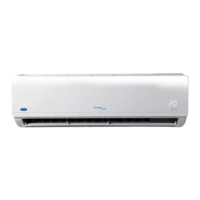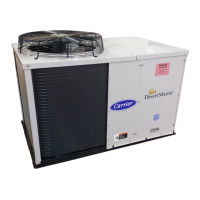23
at any given time. All types of heating are still performed under the
general heating function, and the expanded text is for user
reference only.
For the unit to be allowe d t o ent er the heat mode , three things must be
true: the indoor f an must be ok to use , the mode changeove r ti me
guard must be expired, a nd the re mus t be a heating dema nd. The unit
will remain in heating for at least one minute and until the demand is
dropped or if a ny of the above cond i tions ar e false. The heating mode
does not officially end until all heat stages are off, the fan off delay has
expired, and the IGC fan request is dr opped.
Supply--Air Temperature Sensor (SAT) Heat Mode
The SAT He at Mode Sens ing (SAT DURI NG HEAT?) informs the
unit tha t the suppl y air sensor has been r elocated downstream of the
heat se ction. This conf iguration affe cts the Suppl y Ai r Temperature
(SUPPL Y AIR TEMP) value displayed as listed below.
When SAT DURING HEAT? is disabled, the Supply Air
Temperature (SUPPLY AIR TEMP) value on the SystemVut
display and the network will hold a zero when heat outputs come
ON and for 5 minutes after. The default SAT sensor location is at
the fan inlet, upstream of the heat section.
When SA T DURING HEAT? is enabled, the Supply Air Temperature
(SUPPL Y AIR TEMP) sensor reading is displayed at the SystemVu
controller and network during heating mode. This setting should only
be used if the original SAT sensor wires are re moved fr om the Ma in
Base Board (MBB) and replaced by an accessory SAT sensor located
in the supply duc t downs t ream of the he at se ction.
Heating Staging Control
Once the unit is in a heating mode, it determines what the demand
is and how to satisfy it. Requested Heating Stages (REQ. HEAT
STAGES) will be determined then passed to heat control to
actually add the heating stages. To request stages the number of
heat stages (HEATING STAGE QTY) must be greater than zero.
As a gas unit this will be set in the factory, however 50LC units
may have heat installed as accessories. If the Outdoor Air
Temperature (OUTDOOR AIR TEMP) is greater than the Heating
Lockout Temp (HEAT LOCKOUT OAT), all the heat stages will
be locked out (HEAT LOCKOUT).
There are two ways of requesting stages when thermostat control is
enabled, traditional thermostat control or adaptive control.
Traditional thermostat control is used if set for non-- adaptive
thermostat (ADAPTI VE TST AT = NO). If se t f or adaptive the rmost at
(ADAPTI VE TSTA T = YES), the unit will use adaptive control for
staging. When configured for space sensor or RAT control (UNIT
CONTOL TYPE) the unit will use adaptive control for staging.
With either staging method there are then two supply air
temperature limits, the Maximum SAT Lower Level (LOWER
MAX SAT) the Maximum SAT Upper Level (UPPER MAX SAT).
Any time the supply air temperature rises above lower level the
heat staging will be limited to what is currently on and no
additional stages will be added until the supply air temperature falls
back below the lower level. If the supply air temperature rises
above the upper level, then heating will be reduced by removing
one stage. That stage will not be added again until the Supply Air
Temperature falls below the lower level. If the supply air
temperature stays above the upper level, then another stage will be
removed. If the upper and lower levels are configured so that they
are close together, the last stage of heat might cycle rapidly, slowed
only by its minimum on and off--time requirements.
Adaptive Control
Stage timers and Supply air trend apply when determining the
request for stages. The first request (REQ. HEAT STAGES =1)
comes immediately when starting the staging process. The Heat
Stage Increase Time (HEAT STAGEUP TIME) has to expire and
the Supply--Air Trend (SUPPLY AIR TREND) has to be above
the Heating supply air trend level (HEAT SATTREND LEV)
before another stage can be added. Requested stages will only be
allowed to increase as the actual system demand allows
(DEMAND). A “LOW HEAT” will only allow one requested stage
and “HIGH HEAT” 2 stages. The requested stages will be reduced
if the heating demand is lowered or dropped completely, or if the
supply air falls below the lower level (LOWER MIN SAT).
Traditional Thermostat Control
Stage timers and Supply air trend do not apply when determining
the request for stages. Request staging will follow the thermostat
inputs directly. “LOW HEAT” will request one stage. “HIGH
HEAT” will request 2 stages.
Heat Relay Control
The heat relay control is re s ponsible for energizing or de--e nergizing
the hea t st age relays a nd wor ks hand and hand with the st aging
control. As the staging control requests stages, the heat relay control
determines what actual heat relays are available or energized and tries
to provide stages for what is requested. The availability of heat relays
depends on the he at instal led, how ma ny st ages, and time guar ds. The
Number of Heat Stages (HEATING STAGE QTY) configuration tells
the control how many heat re lays ca n be used. Heat Stage 1Timegua r d
(HEAT 1 TIMEGUARD) and Heat Stage 2 Timeguard (HEA T 2
TIMEGUARD) display the time a respective heat relay has before it
can cha nge st ate. The available stages at any given ti me ar e dis played
as heat 1 available and hea t 2 available (HEAT 1 AVAILABLE and
HEAT 2 AVAI LABLE) . The actual heat relays on at any given time
are displayed as Actual Heating Stages (ACTVE HEA T ST AGE) .
Heat Stage 1 Relay (HEAT 1 RELA Y) and Heat Stage 2 Relay
(HEAT 2 RELA Y) are displayed on when the respective relay is
ener gi zed. There are time guar ds to prot ect from shor t cyc ling, He at
Minimum On Time (HEAT MIN ON) and Heat Minimum Off Time
(HEAT MIN OFF) apply before a heat relay can be turned back on
or turned off.
Integrated Gas Controller (IGC)
The heat staging is determ i ned as described above and the Integrated
Gas Controller (IGC) initiates the gas heat module st art--up. The
Integrated Gas Controller (IGC) minimum on--time of 1 minute will
be followed even if Hea t Minimum On T ime (HEAT MIN ON) is
lower and during Service Test. If the IGC temperature limit switch
opens within 10 mi nute s of the e nd of the gas he at c ycle, the next fan
off delay wil l be extended by 15 se conds. The maxi mum del a y is 3
mi nut es. Once modified by the I GC , the fa n of f del ay will not change
back to the configured Fan--off Delay , Gas Heat (HEAT FANOFF
DELAY) unless power is reset to the control. A light emitting diode
(LED) is provided on the IGC to indicate st atus. Duri ng normal
operation the LED is cont inuously on. See the T r oubleshooting
section if the LED is off or fl ashing. The IGC is located behind the
gas section access panel door.
When the control energizes Heat Stage 1 Relay ( HEAT 1 RELA Y) ,
power is sent to the W terminal on the IGC board. A check is made to
ensure that the rollout switch and limit switch are closed. The
induced--draft motor is then energized, and when speed is proven with
the Flue Gas Pressure switch on the motor, the ignition activation
period begins. The burne r s wil l ignit e wit hin 5 seconds. If the burne rs
do not li ght, there is a 22--second del ay bef or e anot her 5--se cond
attempt. If the burners still do not light, this sequence is repeated for
15 minutes. After the 15 minutes have elapsed, if the burners still have
not lit, heating is locked out. The control will reset when the request
for heat is temporarily removed. When ignition occurs the IGC board
will continue to monitor the condition of the rollout switch, limit
switches, the Flue Gas Pressure switch, as well as the flame sensor . If
the unit is cont rolled through a room the rmostat or spa ce sensor se t for
auto--fan, 45 s econds after ignition occurs the indoor--fan motor will
be energize d (a nd the outdoor--ai r damper s wil l open to their
mi ni m um position) . If for some reason the over temperature lim it
opens pri or to the start of the indoor fa n blower, on the next attempt,
the 45--se cond delay wil l be shortened to 5 seconds less than the ti m e
from initiation of heat to when the limit tripped. Gas will not be
interrupted to the burners a nd heating will conti nue. Onc e modi f ied,
the fa n on delay wil l not cha nge bac k to 45 se conds unless power is
reset to the control. When the control energizes Heat Stage 2 Relay

